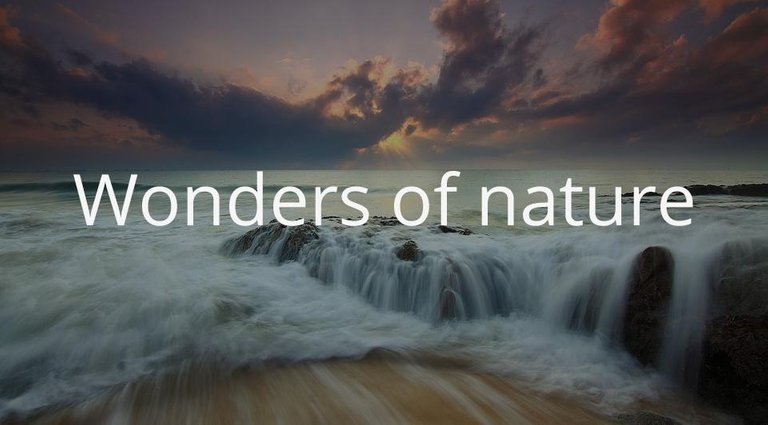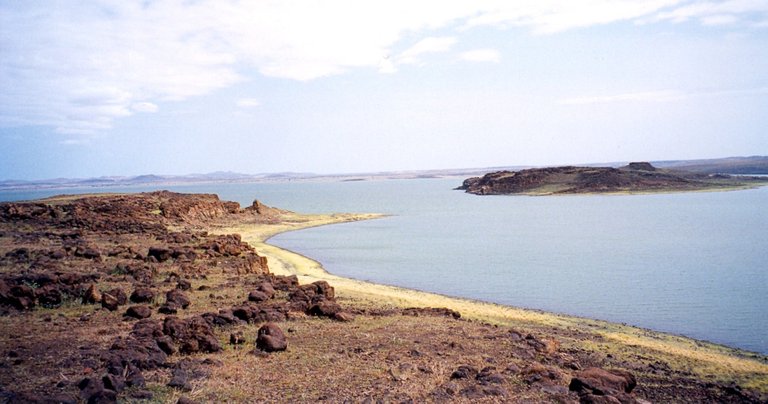
The river flowing along the surface of the lake created its own "highway" from the silt.
Right along the wide surface of Lake Rudolph, the river bed winds with so regular shores that they seem to be created by man. At 5 kilometers from the shore of the lake the riverbed turns into a branched delta, similar in form to the track of a giant bird.
Here ends the Omo River, whose sources are located 640 kilometers from here, in Ethiopia. River waters make their way south through the most beautiful gorges, until they spread out on the plain. Having become brown from silt, they pour into the bright green waters of Lake Rudolph in Northern Kenya.
No matter how much sewage and debris is carried by the river water, it is still lighter than the lake, dense from the volcanic substances dissolved in it. Therefore, a fast river flows over the surface of the lake, gradually slowing down, laying silt and plant debris. And from this, it has its own onshore banks. When its current weakens, it spreads in the form of a delta and, finally, merges with the lake itself.

In the lake Rudolph, the length of which is 312 kilometer, several rivers flow into the lake, but no river flows out of it. Long ago, when the rivers were much fuller, the water level in the lake was probably 180 meters higher. And then the water drained from the lake to the Nile through the gorge at its northwestern end; however, the water level dropped, and the canyon became completely dry.
Over the centuries, ashes and lava erupted from the volcanoes surrounding the lake. All this was washed away into it and accumulated in the form of mineral salts, including sodium carbonate, better known as washing soda.
Lake Rudolph is so far removed from civilization that only the most daring travelers and enthusiastic anthropologists have been there. Their efforts were generously rewarded, as in the lake lives a myriad of crocodiles, hippos and waterfowl.

About 12,000 crocodiles live in Lake Rudolph and near it. They are among the largest in the world (up to 5.5 meters in length), but do not pose a threat to humans and animals, since they feed on huge Nile perch, which are abundant in the lake. If you quietly stand by the water at night, you can hear the clatter of huge jaws. Crocodiles, united in a group, drive the fish to the shore, gradually becoming saturated.
The main breeding place for crocodiles is Central Island. Here they produce offspring for almost 130 million years. Apparently, because of the water content of soda in crocodiles on the belly, horny growths are formed. This made their skin unsuitable for making shoes or ladies' bags, which probably saved them from extermination.
Collective pelican hunting
The abundance of fish is a paradise for birds: the osprey, spoonbills, herons, ibis, cormorants, ducks, geese and also large pink pelicans. It seems that pelicans use the same method for catching fish as crocodiles. They line up in one line and swim together ahead, and then, as if on command, they lower their beaks into the water and pull out the fish.
Since the beginning of the 70's around the world, the lake Rudolph began to be called the local name of Turkana. The first European to see him in 1897 was Count Samuel Teleki von Chek, who named him in honor of the Crown Prince of Austria. The count was a Hungarian geographer and sportsman. Accompanied by a large and well-equipped caravan of 450 porters and 6 guides, he passed through the whole territory.
The lake was the last missing link in the chain, which was made by Austrian geologist Eduard Suess. He saw the regularity in the location of lakes and rivers stretching from Lake Nyasa in South Africa to the Jordan River in the Middle East, and suggested the existence of a dip in the earth's crust, now known as the East African rift system.

It was at Lake Rudolph that anthropologists worked for decades, which led to the discovery of the most ancient remains of human ancestors in the world.
They found out that ancient people inhabited this territory 2 million years ago and moved on two legs - this was evidenced by imprints on volcanic rocks. Stone axes for hunting literally dot the ground in some places.
Rich fossil finds were the result of the fact that for thousands of generations, bones accumulated here and they were covered with new layers of sediments and volcanic lava. Subsequent movements of the earth's crust carried these layers back to the surface, thus creating a unique laboratory for studying the life of prehistoric man.
Harvesting from the lake
Of all the tribes living near the lake, only two - the Turkana and the El-Molo - are anglers.
Night fishing with the turkan is amazing and exciting. Standing in shallow water, a fisherman waving a bundle of smoldering dry grass, the light from which draws fish to the shore. Then, holding the basket of rods in the other hand, he skillfully pulls the fish near the bottom. People of the Turkman tribe living on the western shore of the lake also use rope attachments with stones stuck on them, fishing for Nile perch, which can weigh up to 90 kilograms.
El-Molo means "people who live by fishing". These experienced fishermen catch fish, as well as crocodiles with the help of nets or spear, balancing on rafts from palm trunks.
Nice presentation. Thanks for sharing!
Thank you =)
Peace, Abundance, and Liberty Network (PALnet) Discord Channel. It's a completely public and open space to all members of the Steemit community who voluntarily choose to be there.Congratulations! This post has been upvoted from the communal account, @minnowsupport, by Mamasetta from the Minnow Support Project. It's a witness project run by aggroed, ausbitbank, teamsteem, theprophet0, someguy123, neoxian, followbtcnews/crimsonclad, and netuoso. The goal is to help Steemit grow by supporting Minnows and creating a social network. Please find us in the
This post has received a 0.52 % upvote from @drotto thanks to: @banjo.